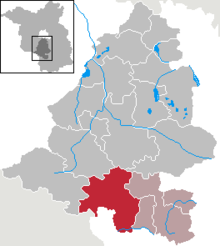Schlenzer burial ground
The late Bronze Age grave field of Schlenzer in the area of the municipality of Niederer Fläming in the district of Teltow-Fläming ( Brandenburg ) came to light in 1999 during the construction of the JAGAL gas pipeline (at route kilometer 135) in the slope area of a crest of the "Niederen Fläming ". Due to the state of research, finds of the Lausitz culture and the urn field culture have been rare in the region to date. The location of the associated settlement is unknown.
Overview
About 60 findings were examined on an area of around 2900 m². The focus was on 19 cremation burials of various types. A vessel depot , a circular moat, as well as several additional finds , which presumably belong to unrecognized graves and a number of unclassifiable soil discolorations, were recorded.
The extent of the burial ground is unknown, as the northern area, including part of the circular trench , had been destroyed years ago when an oil pipeline was built, and agriculture had caused considerable damage. Concrete statements about the construction of the graves and the equipment of the graves are therefore difficult and the original occupancy density of the grave field remains unclear.
Incendiary graves
All identified cases are cremations. The corpse burn was mostly spread in a burial complex, which was partly complex and partly simple. The structurally designed grave complexes have different shapes and sizes, ranging from stone chambers (grave 3) to simple stone enclosures that are oval, rectangular or round. In the other cases, it is urn graves or fire pouring. In grave 4, which consists of a simple pit without built-in components, and in grave 7, the corpse burn was scattered in body shape. The floor of grave 7 was carefully laid out with stone slabs, which was also observed in other graves. In addition, there were sods, as can be assumed based on dark, humic areas.
The equipment of the dead consisted of a few bronzes and a varying number of usually shattered vessels, which had been selected from the remains of the pyre along with the corpse burn. Grave 7 contained six complete vessels . The shards were sometimes carefully laid out, built with the stones, or strewn like corpse fire. Bronze jewelry, as was common at the time, was rarely found. Worth mentioning but not exactly determinable are a needle and a ring fragment, a small bronze spiral (possibly a needle fragment) and a tightly ribbed arm ring fragment.
The circular moat
The circular moat with a diameter of around 15 m is not uncommon on the burial grounds of this era. It could also be the remains of a completely plowed-up burial mound. It is worth highlighting an earth bridge in the south of the trench and its two-phase nature. On the bottom of the upper backfill, smaller stones were found in many places, and occasionally shards above that, which in turn were covered with larger stones. One area to the southwest showed a concentration of shattered vessels and other shards about 2.5 m long. In some places small fires appear to have burned. The circular moat, whether as a remnant of a burial mound or as an independent element, is likely to have played a role in burial ceremonies or other occasions during the time the burial ground was occupied.
literature
- H. Peter-Röcher & M. Roeder: A late Bronze Age cemetery on the Lower Fläming In: Brandenburg State Office for Monument Preservation and State Archaeological Museum Wünstorf (Ed.) Archeology at the JAGAL Wittenberg 1999 p.38.39 ISBN 3-910010-48 -2
